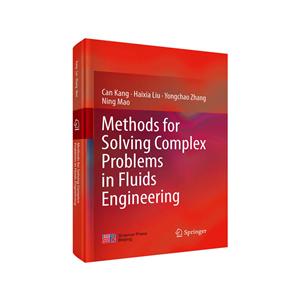扫一扫
关注中图网
官方微博
本类五星书更多>
-
>
湖南省志(1978-2002)?铁路志
-
>
公路车宝典(ZINN的公路车维修与保养秘籍)
-
>
晶体管电路设计(下)
-
>
基于个性化设计策略的智能交通系统关键技术
-
>
德国克虏伯与晚清火:贸易与仿制模式下的技术转移
-
>
花样百出:贵州少数民族图案填色
-
>
识木:全球220种木材图鉴
流体工程中复杂问题的研究方法(英文版) 版权信息
- ISBN:9787030587503
- 条形码:9787030587503 ; 978-7-03-058750-3
- 装帧:一般胶版纸
- 册数:暂无
- 重量:暂无
- 所属分类:>
流体工程中复杂问题的研究方法(英文版) 内容简介
康灿、刘海霞、张永超、毛宁编的《流体工程中复杂问题的研究方法(英文版)(精)》描述了*近发展起来的研究方法,用来研究复杂流体工程中存在的问题,特别是光学流量测量,流量可视化和数值方法。它包含了大量的图表和图片。收录了《 Introduction to Complex Problems in Fluids Engineering》《A Brief Overview of Research Methods》《Submerged Waterjet》《Motion of Bubble》等。
流体工程中复杂问题的研究方法(英文版) 目录
1 Introduction to Complex Problems in Fluids Engineering
1.1 Background Knowledge
1.2 Strategies for Treating Complex Flows
1.2.1 Fundamental Flow Features
1.2.2 Common Methods for Treating Flow Issues
1.3 Characteristics of Flow Problems
1.3.1 Flow Quantities
1.3.2 Unsteadiness
1.3.3 Symmetry
1.3.4 Stability
1.3.5 Symmetry,Intermittency and Periodicity
1.3.6 Phase Change
1.3.7 Flows in an Integrated System
References
2 A Brief Overview of Research Methods
2.1 Introduction of Experiment
2.1.1 Definition of Experiment
2.1.2 Experimental Instruments
2.1.3 Fidelity of Experiment
2.2 Numerical Methods for Flows
2.2.1 Governing Equations
2.2.2 Turbulence Model
2.2.3 Turbulent Characteristics
2.2.4 Cavitation Model
2.2.5 Other Issues
2.3 Some Limitations of CFD
2.4 Structural Analysis
References
3 Submerged Waterjet
3.1 Fundamental Features of Submerged Waterjet
3.1.1 Experimental Set-Up
3.1.2 Average Flow Characteristics of Submerged Waterjet
3.1.3 Vorticity Distribution and Pressure Fluctuation
3.1.4 Cavitation
3.2 Submerged Waterjet Issued at Ultra-High Jet Pressures
3.2.1 Cavitation Erosion Mechanism
3.2.2 Experimental Methods and Rig
3.2.3 Results and Analysis
3.2.4 Summary
3.3 Cavitation Simulation for Submerged Waterjet and Experimental Validation
3.3.1 Numerical Model and Procedure
3.3.2 Discussion of Numerical Results
3.3.3 Cavitation Prediction
3.3.4 Experimental Setup
3.3.5 Experimental Results
3.4 Concluding Remarks
References
4 Motion of Bubble
4.1 Rising Bubble in Stationar} Water
4.1.1 Experimental Set-Up and Image-Processing Code
4.1.2 Experimental Results and Analysis
4.1.3 Summary
4.2 Bubbles Released in Horizontal Water Flow
4.2.1 Experimental Preparations
4.2.2 Results and Discussion
4.2.3 Bubble Deformation and Dimensionless Numbers
4.2.4 Summary
References
5 Wake Flow of the Ventilation Cylinder
5.1 Experimental Setup
5.1.1 Water Tunnel and Ventilated Cylinder
5.1.2 Optical Configuration
5.1.3 Bubbles Separation Algorithm
5.2 Velocity and Vorticity Distributions
5.3 Bubbles Size Prediction
5.3.1 Bubbly Flow Patterns
5.3.2 Bubble Size
5.3.3 Comparison of Bubble Size Distribution
5.4 Bubble Velocity Distribution
5.5 Statistical Features of Bubble Volume
5.6 Concluding Remarks
References
6 Drag-Type Hydraulic Rotor
6.1 Introduction
6.2 Experimental Setup
6.2.1 Drag-Type Hydraulic Rotor
6.2.2 Test Segment of the Water Tunnel
6.2.3 PIV Set-Up
6.3 Flow Patterns Near the Hydraulic Rotor
6.3.1 Wake Flow Patterns
6.3.2 Flow Characteristics Near the Rotor
6.3.3 Vorticity Distribution
6.4 Numerical Preparations
6.4.1 Governing Equations and Turbulence Model
6.4.2 Grid Deployment Scheme
6.4.3 Boundary Conditions
6.5 Validation of Numerical Simulation
6.6 Variation of Torque Coefficient with Rotor Rotation
References
7 Viscous Flows in the Impeller Pump
7.1 Introduction
7.2 Pump Structure and Parameters
7.3 Numerical Preparations
7.3.1 Governing Equations and Turbulence Model
7.3.2 Boundary Conditions
7.3.3 Verification of Numerical Settings
7.4 Results and Discussion
7.4.1 Pump Performance
7.4.2 Flow Patterns
7.4.3 Pressure Fluctuations
7.5 Hydraulic Forces Exerted on Impeller Blades
7.6 Concluding Remarks
References
8 Cavitation in the Condensate Pump
8.1 Introduction
8.2 Cavitation Feature of the Centrifugal Pump
8.3 Modification of Impeller Geometry
8.4 Pump Performance Experiment
8.5 Numerical Preparations
8.5.1 Governing Equations,Turbulence Model and Cavitation Model
8.5.2 Grid Deployment Scheme
8.5.3 Boundary Conditions
8.5.4 Validation of the Computational Scheme
8.6 Numerical Results and Discussion
8.6.1 Geometric Features of Cavitation
8.6.2 Effect of Flow Rate on Cavitation at NPSHa=3.0 m
8.6.3 Effect of NPSHa on Cavitation at Design Flow Rate
8.7 Conclusions
References
9 Structural Aspect of the Impeller Pump
9.1 Flow-Structure Interaction in the Molten Salt Pump
9.1.1 A Brief Introduction of the Molten-Salt Pump
9.1.2 Numerical Set-Up for Flow Simulation
9.1.3 Flow Characteristics of the Pump
9.1.4 Numerical Setup for Structural Calculation
9.1.5 Temperature Distribution in the Rotor
9.1.6 Strength Analysis of the Rotor
9.1.7 Modal Analysis
9.1.8 Summary
9.2 Structural Improvement of a Condensate Pump
9.2.1 Overview of the Condensate Pump
9.2.2 Condensate Pump and Vibration Description
9.2.3 Flow Simulation for the Pump
9.2.4 Motor Test
9.2.5 Modal Analysis of the Original Pump Base
9.2.6 Improvement of Motor Supporting
References
展开全部
书友推荐
- >
经典常谈
经典常谈
¥12.7¥39.8 - >
我从未如此眷恋人间
我从未如此眷恋人间
¥32.4¥49.8 - >
姑妈的宝刀
姑妈的宝刀
¥9.0¥30.0 - >
山海经
山海经
¥17.7¥68.0 - >
诗经-先民的歌唱
诗经-先民的歌唱
¥13.5¥39.8 - >
月亮与六便士
月亮与六便士
¥18.1¥42.0 - >
小考拉的故事-套装共3册
小考拉的故事-套装共3册
¥36.7¥68.0 - >
新文学天穹两巨星--鲁迅与胡适/红烛学术丛书(红烛学术丛书)
新文学天穹两巨星--鲁迅与胡适/红烛学术丛书(红烛学术丛书)
¥9.9¥23.0
本类畅销
-
油田化学(富媒体)
¥38.5¥50 -
煤矿企业主要负责人考试手册:2018
¥30.2¥68 -
燃烧学
¥20.2¥48 -
地面生产保障、其他管理及后勤服务作业安全培训教材(煤矿从业人员培训教材)
¥23.6¥30 -
煤矿岗位作业流程标准化示范
¥50¥68





















